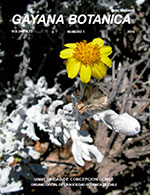Natural regeneration and spatial distribution patterns of Chilean palm Jubaea chilensis (Molina) Baillon in Mediterranean forests of Central Chile
Keywords:
Spatially explicit models, nurse effect, Mediterranean climate, herviboryAbstract
ubaea chilensis is an endemic tree of Central Chile (31º15’-35º22’ S). The current main conservation threats for this species should be associated with different factors which limit its natural regeneration, in particular the intense seeds crop. The analysis of spatial distribution patterns can be an important tool to understand the forest dynamic and the individual interactions. In this study was studied the spatial pattern of species recruitment and identifying the proper conditions for its regeneration. We predicted a clear spatial clumped pattern between regeneration individuals for all distance range studied, and also a clumped distribution associated to adult individuals. Spatial modeling showed that natural regeneration of J. chilensis is significantly related to higher vegetation cover, and especially in those with higher solar radiation. The results suggest that clumped regeneration of J. chilensis could be explained by the associated environmental conditions promoting the establishment of new seedlings, its seed dispersal mechanism, predation avoid, herbivory, and seeds crop. We also found a nurse effect which facilitates the natural regeneration of this species.
Downloads
Metrics
Downloads
Published
How to Cite
Issue
Section
License
Authors who publish with this journal agree to the following terms:
- Authors retain copyright and grant the journal right of first publication.
- The articles in this journal are published under Creative Commons Attribution-NonCommercial 4.0 International License that allows others to share the work with an acknowledgement of the work's authorship and initial publication in this journal.
- Authors are permitted and encouraged to post their work online (e.g., in institutional repositories, on their website or ResearchGate) prior to and during the submission process, as it can lead to productive exchanges, as well as earlier and greater citation of published work (SeeThe Effect of Open Access).













